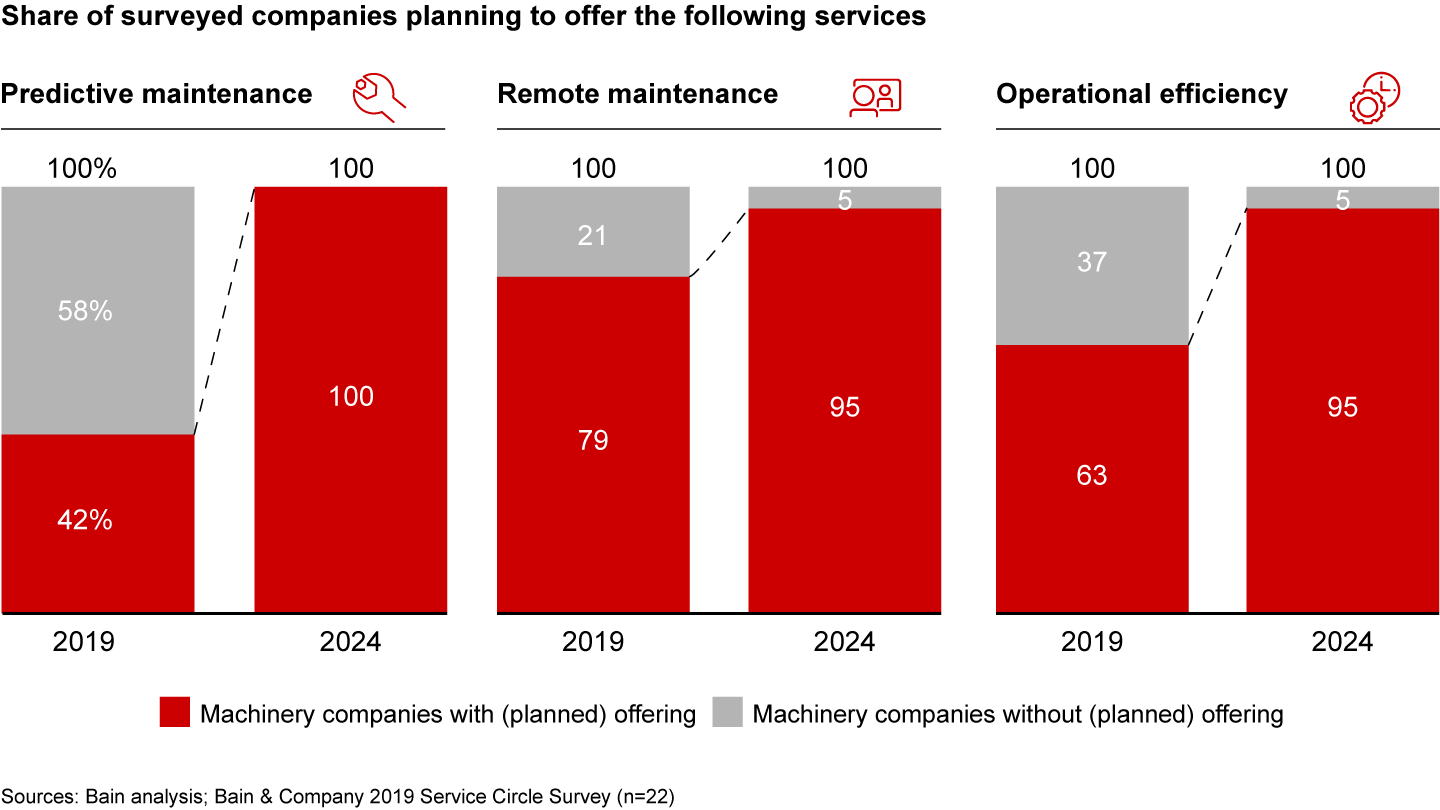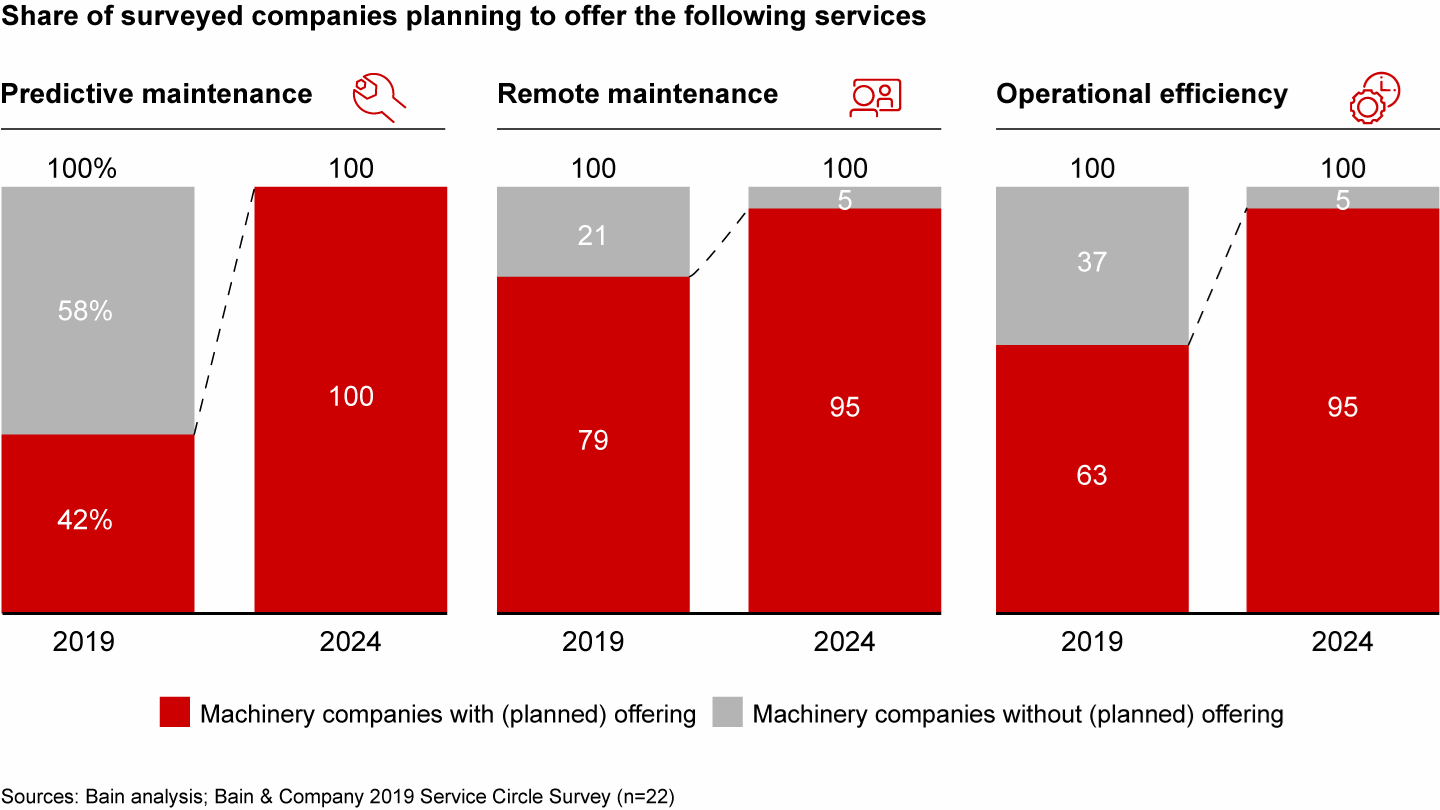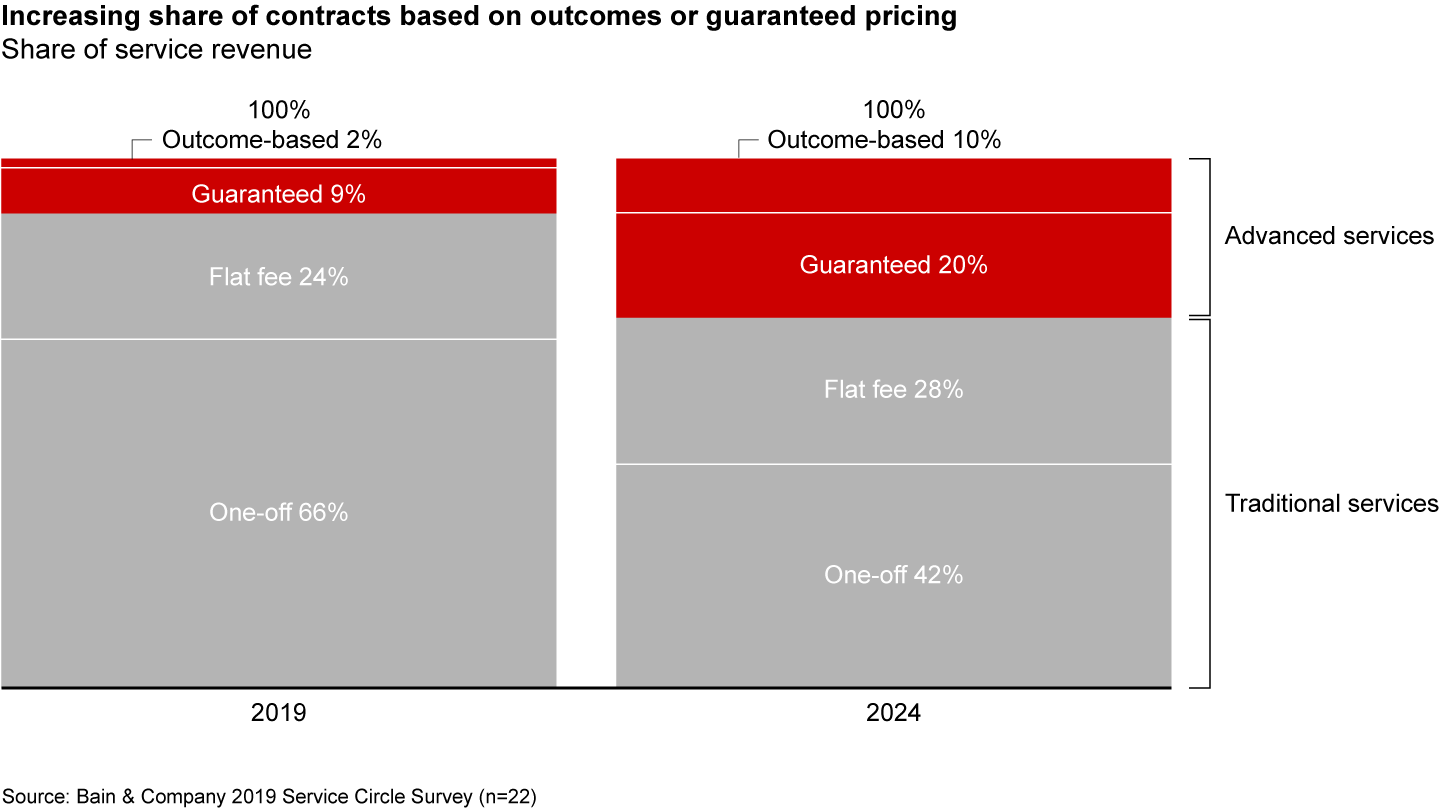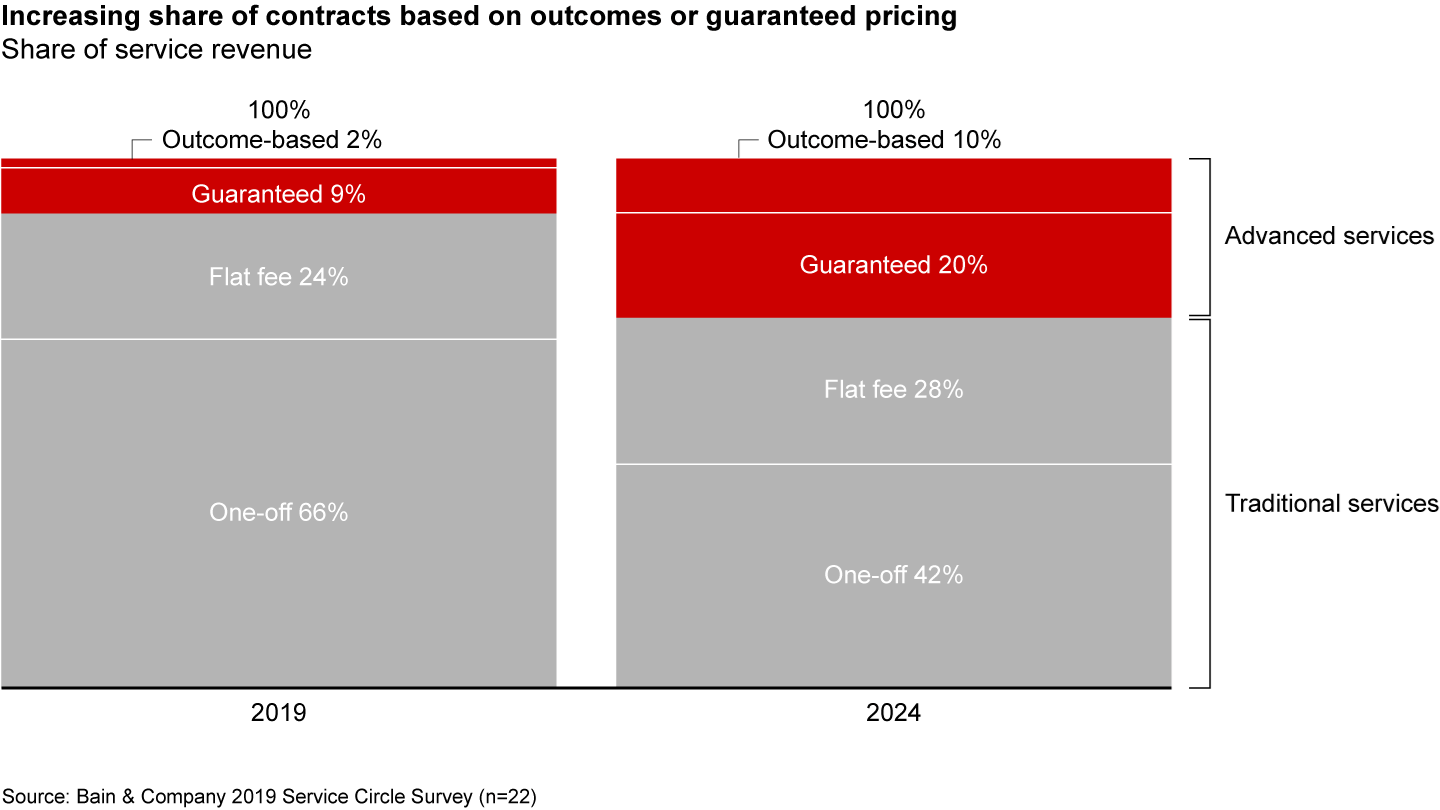Global Machinery & Equipment Report

In evidenza
- By 2030, companies will sell most equipment as part of bundled solutions.
- Tech-savvy competitors are using their data expertise to compete for a share of the global plant monitoring and optimization market.
- To win in services and solutions, OEMs now need to collaborate more closely with their customers.
This article is part of Bain's Global Machinery & Equipment Report 2022
Machinery companies face a tectonic shift. Industry 4.0 technologies are reshaping the business from one built around machines to one focused on services and integrated solutions. In some sectors, individual companies already generate more than 50% of revenues and 100% of profits with services. That trend is accelerating and will become the norm across the industry over the next few years. By 2030, companies will sell most equipment as part of bundled solutions including software and services, reducing hardware’s share of total profits.
Tech-savvy rivals are taking advantage of that disruptive opportunity and moving into the market with services based on connectivity and enhanced data. Leading cloud solutions providers are targeting segments of the machinery profit pool with solutions such as global plant monitoring and optimization, leveraging their data expertise and an Internet of Things platform. The country undergoing the fastest shift is China, where tech start-ups and other insurgents are introducing a new generation of innovative service offerings.
To defend their turf, leading original equipment manufacturers (OEMs) are increasing investments in digital technologies and accelerating their rollout of advanced services. And they are snapping up software companies to improve their offerings. More than 40% of acquisitions executed by machinery OEMs have distinct capabilities in software or cloud technology (up from less than 20% 10 years ago).
Building on a deep knowledge base and decades of experience, OEMs are redefining traditional machinery service as strategic care and designing new services that help customers perform better throughout the full life cycle of the installed machinery base. Of the OEMs we surveyed, 100% say they plan to offer predictive maintenance by 2024. Ninety-five percent of OEMs say they will provide remote maintenance, and 95% will offer operational efficiency services (see Figure 1).
Advanced services are becoming a core offering for machinery companies


As these services go mainstream, the shift toward integrated solutions will accelerate, particularly for solutions tailored to increasing production efficiency, improving financial performance, and supporting sustainability goals. Our report examines this critical trend toward solutions from two perspectives—the technology shift and the transformation of service offerings. Although most services are destined to be integrated into solutions, they remain today an integral part of the company’s portfolio—and a key to profitability. For most companies, that means redoubling the strategic focus on advanced services while laying the groundwork for a digital solutions future.
New priorities
To win in services and solutions, OEMs now need to collaborate more closely with their customers. Advanced service contracts, for example, are broader in scope and may cover a full production line, all the equipment at a given site, multiple plants, or even an entire fleet. Importantly, they rely on data and analytics to improve machine function and process performance. The most effective equipment makers compile data and insights from their installed base and use the information to build innovative service solutions. For comparison, imagine how data and analytics have transformed marketing, allowing consumer goods companies to tailor their campaigns precisely to customer tastes and preferences.
Companies leading the shift to advanced services and solutions understand that equipment and service are no longer two separate businesses but are deeply interconnected. Think about how smart, data-based solutions such as traceability or energy management can help customers meet their sustainability goals. A company that can prove that the steel it uses is green, for example, will have a powerful competitive edge in the coming decade as consumers, investors, and governments push for ever more stringent ESG standards.
However, new performance-based business models involve taking risk and managing risk. In these contracts, OEMs guarantee an agreed level of output or quality based on a predefined set of performance indicators that are then reported in real time. Leadership teams will need to move up the learning curve gradually to gain experience with specific use cases, especially on pricing new solutions.
Fast-moving market
As global machinery companies rethink services, they are transforming the rules of the game, focusing on customer performance, data-driven services, and the digitizing of the service experience. And nowhere is that shift happening faster than in China.
China’s rapidly evolving market is a window on how powerful incumbents and nimble start-ups are reinventing services. Chinese machinery companies and digital challengers started innovating in services a decade ago to spur growth as equipment sales slowed. The market is now a vibrant test bed for a future service- and solutions-based industry. Eager to get a firsthand view of that paradigm, a leading US equipment maker recently teamed up with a large Chinese tech company to experiment in the country’s fast-moving services market and share risk.
China’s rapidly evolving market is a window on how powerful incumbents and nimble start-ups are reinventing services.
One Chinese OEM that has reinvented its service offering is heavy equipment maker XCMG. The company’s Internet platform, which provides services such as machine analysis, average working time analysis, equipment utilization data, and connected plants, has generated massive growth since its launch eight years ago. At the end of 2021 it connected more than 460,000 machines. XCMG says its services give companies a competitive edge: greater efficiency and faster decision making based on data.
While OEMs invest in new technologies, agile Chinese start-ups have started selling low-cost equipment service solutions on cloud-based platforms. The cloud service Machine Commander, offered by the Chinese start-up Zeaho, is one example. Providing real-time monitoring of construction sites to improve equipment efficiency, it has 135,000 units of equipment connected to its cloud-based platform—after just seven years.
Other cloud-based platforms in China offer value-added services in fleet and facility management. One harnesses artificial intelligence and machine learning to route large field force teams of 1,000 or more to the next job in real time, dramatically improving their efficiency.
Four key steps
The lesson OEMs are drawing from China is clear: The opportunity in advanced services is huge, and there’s no time to lose. For many companies, advanced services may still feel like a leap into the unknown, but leadership teams that delay investing in digital technologies risk ceding a share of their service business to nimbler rivals. In our experience, four key steps can help OEMs reshape their business for a new era, move closer to their customers, and win in an increasingly competitive market:
1. Digitize and connect the installed base
Invest in connected equipment and cloud-based platforms to create a valuable trove of information about customers and their equipment. Digital tools allow most regular customer support to be managed remotely, reducing costs involved in servicing the installed base and dramatically improving the overall efficiency.
Digital portals also provide customers access to vital operating data, enhancing the OEM-customer relationship and collaboration. Sensors embedded in connected equipment can help OEMs anticipate machinery failures before they happen and offer customers a quantum leap in preventive maintenance. And, as many leaders know, upgrading and connecting the existing installed base is a growing business.
2. Develop digital service solutions
Harness data to derive insights and design more innovative service models, including optimal service schedules and offerings tailored to customers’ needs. One category of next-generation solutions links fees to operational performance. Equipment makers, for example, can offer to guarantee the uptime or output of their machinery.
Services designed as solutions can be a win-win scenario for equipment makers and their customers. While improving efficiency and reliability for clients, performance-based contracts increase an OEM’s competitive edge, boost service revenue, and grow its share of the service profit pool. Remote monitoring and predictive maintenance are familiar examples. Other uses include pattern-recognition algorithms that can crawl through thousands of hand-typed reports about machinery breakdowns. The insights gleaned help service teams better manage equipment under contract and develop standard upgrades that can be sold throughout the installed base of customers.
3. Sell equipment as a service
To tailor services to customers’ needs, leading OEMs are developing subscription-based business models. Take the case of Atlas Copco, a global maker of compressors that also sells compressed air as a service. For customers, the shift to a machinery-as-service contract eliminates machinery downtime and ensures an uninterrupted supply with minimum investment. For Atlas Copco, the new contracts also offer benefits, minimizing unnecessary customer maintenance visits and securing aftermarket sales and service over a long period with one customer interaction. Importantly, the data and experience gathered from a worldwide base of connected equipment can be used to further enhance products.
Service relationships built on improving customer productivity increase loyalty and encourage deeper and more lasting customer relationships. One global leader in plant engineering used its trove of data and analytics to continuously improve a customer’s shop floor results by forecasting maintenance requirements and alerting workers to changes in quality. Digital tools tracking the data of on-site machinery were able to forecast that a machine would break down before it happened. That won respect from the customer’s management team—and generated a long-term contract.
4. Share the risk
Rising cost pressure has made traditional pricing models based on billed man-hours less attractive for customers. Increasingly, customers want solutions that minimize their risk and provide more predictability, including outcome-based offerings. New technologies such as big data and machine learning are bridging that divide.
Outcome-based services, for example, can reduce customer risk while increasing service revenues and profit. Instead of fixing equipment when it breaks down for a flat fee, the companies offering these services ask for a percentage of the guaranteed output. Similarly, contracts can focus on reducing energy use or boosting equipment efficiency. Bain research shows that the share of contracts based on outcomes or guaranteed pricing is likely to rise to 30% by 2024, up from 11% in 2019 (see Figure 2).
Machinery companies expect advanced services to produce 30% of their service revenue by 2024


One global engineering firm that builds and maintains industrial plants overcame slow service revenue growth by incorporating outcome-based offerings into its service portfolio. Data collected from its installed based helped the company identify important ways to improve plant efficiency. That paved the way for service contracts that guarantee an improvement in operating efficiency and pay the engineering firm a percentage of the savings (for example, from the reduction in energy consumption). The outcome-based offerings triggered significant growth in service revenue and profitability.
Workforce implications
As leading companies lay the foundations for a solutions-based portfolio, they are making critical changes to organizational roles and responsibilities. They recognize that advanced services and solutions have profound implications on talent and workforce management. The service team of the future, for example, will need expertise in analytics and remote management. OEMs will also need new skills and capabilities to design advanced services—and manage the risk of performance-based contracts.
Frontline workers are bearing the brunt of the change as industrial services go digital. Our research shows 46% of technicians at industrial companies find their tools and technology difficult to use. The data highlights the challenge ahead. Companies that don’t think early about what a new era of digital solutions means for workforce management risk lagging the competition.
Winners in the coming decade will make talent a top priority and ensure marketing, sales, and technical teams have the skills and resources they need for the critical transition ahead. Companies launching advanced services and digital solutions are taking a new approach to hiring, development, and retraining. In the field, they are supporting local service teams with digital tools and remote input. At the same time, they are giving service teams the IT and analytics skills to work with digital tools and manage a digitized installed base remotely. That means rethinking the service location footprint, recruiting pools, and career tracks. Finally, they are increasing collaboration and rotations between the service business and new equipment business.
As service innovations and new business models spread quickly across global markets, the next few years will be critical for machinery companies to build their competitive edge in a changing market. OEMs that move quickly now to innovate in services that will help customers increase the lifetime value of their equipment will be well positioned to defend and grow their market share. Success will depend just as much on managing the organizational change and talent needed for a new era.